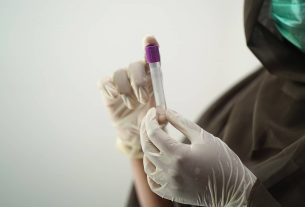Obsessive-compulsive disorder, popularly known as OCD, is a psychological disorder characterized by the presence of 2 types of behavior:
- Obsessions: these are inappropriate or unpleasant, recurring and persistent thoughts that arise in an unwanted way, causing anxiety and suffering, such as, for example, coming into contact with a virus or bacteria and becoming infected. There may also be tics such as hair pulling, nail biting or hoarding objects;
- Compulsions: are repetitive behaviors or mental acts, such as washing hands, organizing objects, checking locks, praying or counting, that cannot be avoided and that, if not done, can cause extreme anxiety.
OCD treatment can be carried out with antidepressant medications, prescribed by a psychiatrist, but must also include psychological therapy, to help the person develop tools that help reduce and/or eliminate the thoughts and behaviors characteristic of the disorder.

Main symptoms
OCD symptoms are more common in people who live with high levels of stress, such as young people and the unemployed, for example. Some of the main symptoms are:
These symptoms can be accompanied by other behaviors, such as eating disorders, accumulation of objects, presence of tics or the habit of biting your nails, for example.
It is important to be aware of symptoms that may indicate that the person suffers from OCD, so that they receive psychiatric treatment.
How to confirm the diagnosis
The diagnosis of obsessive-compulsive disorder is made by a psychologist, or psychiatrist, through a psychological assessment in which the person’s behaviors and thoughts are evaluated.
During this assessment, the professional can rule out other physical problems that may be related to people’s behavior.
Main types of OCD
The content of the thoughts or compulsions of a person with OCD can vary from person to person, and can be of different types, such as:
- Verification: the person feels a compulsive need to check and verify something, as a way to avoid damage, such as fires or leaks. Some common checks include the stove, gas, water taps, house alarm, locks, house lights, wallet or purse, the route of a path, researching illnesses and symptoms on the internet or carrying out self-examinations.
- Contamination: there is an uncontrollable need to clean or wash, and to avoid contamination and dirt. Some examples are washing your hands several times a day, not being able to greet other people or going to environments such as public bathrooms or reception desks at medical offices, due to fear of contracting germs, in addition to the need to clean the house excessively, especially the kitchen and bathroom;
- Symmetry: need to frequently correct the position of objects, such as books, in addition to wanting everything to be ordered to the millimeter, such as arranging clothes and shoes with the same pattern. It is also possible to have symmetry in touches or bumps, such as having to touch with the right hand what was touched with the left or vice versa;
- Counting or repeating: it involves mental repetitions, such as unnecessary additions and divisions, repeating this act several times throughout the day;
- Aggressiveness: in these cases, people are excessively afraid of committing impulsive acts, which arise in thoughts, such as hurting, killing or harming someone or themselves, without meaning to. These thoughts generate a lot of anguish, and it is common to avoid being alone or handling certain objects, such as knives or scissors, without trusting yourself;
- Accumulation: this is the inability to discard some goods, considered useless, such as packaging, old invoices, newspapers or other objects.
There are also other diverse categories, which include varieties of compulsions such as spitting, gesturing, touching, dancing or praying, for example, or obsessions, such as words, images or music that are intrusive and recurring.
How the treatment is carried out
OCD treatment is carried out mainly with behavioral techniques, the most used being systematic desensitization, that is, the professional can gradually expose the person to factors that could previously cause anxiety, anguish or a great desire to make changes to the environment, such as tidying up. asymmetrical objects or cleaning a glass stain on a table, so that the reversal of these habits can be developed.
Another of the most used techniques is cognitive behavioral therapy, which is carried out by a psychologist, where the person will be directed to better understand why obsessive thoughts appear and what is the rational result of not carrying out the compulsions.
In cases where anxiety, in addition to triggering OCD, causes other symptoms such as restlessness and difficulty breathing, the psychiatrist can complement treatment with anxiolytic or antidepressant medications such as:
- Clomipramina;
- Isocarboxazid
- Paroxetine;
- Fluoxetine;
- Sertraline;
- Buspirona;
- Citalopram.
These medications can be used daily, or as directed by your doctor, and can take between 6 and 12 weeks to have the desired effect. Therefore, every 4 or 8 weeks of treatment, the psychiatrist can carry out reassessments and consider the need to adapt the dose.
As OCD can directly interfere with a person’s life, it is important that family and friends are informed about the evolution of symptoms and the types of treatment available.
In the most serious cases, in which conventional treatment has not brought improvement after 5 years in a row, and after several attempts, neurosurgery may be indicated.
Natural Treatment Options
The natural treatment for obsessive compulsive disorder involves using techniques and behaviors that the person can resort to whenever they need to alleviate OCD symptoms, such as meditation, yoga, shiatsu or reiki, for example.
Check out other diet tips to combat stress and anxiety.
Possible complications of OCD
The most common complications in cases of obsessive-compulsive disorder are the inability to work, be in public places or maintain good relationships with other people in any environment. Furthermore, when not treated properly, OCD can continue to worsen and can be a factor in the onset of depression, panic disorder, social phobia or generalized anxiety.
In extreme cases, where the disorder is already very advanced, OCD can resemble psychosis or schizophrenia, due to the degree of disability it brings to people in moments of crisis.
Bibliography
- REV. BRAS. PSYCHIATR. Comorbidity in obsessive-compulsive disorder. 2001. Available at: <https://www.scielo.br/scielo.php?script=sci_arttext&pid=S1516-44462001000600006>. Accessed on September 7, 2020
- OBSESSIVE-COMPULSIVE DISORDER: WHEN UNWANTED THOUGHTS TAKE CONTROL. NIH. Available at: <https://www.nimh.nih.gov/health/publications/espanol/trastorno-obsesivo-compulsivo/index.shtml#pub1>. Accessed on September 7, 2020
- REV. BRAS. PSYCHIATR. Update on neurosurgical treatment of obsessive-compulsive disorder. 2004. Available at: <https://www.scielo.br/scielo.php?pid=S1516-44462004000100015&script=sci_arttext>. Accessed on September 7, 2020
- Psychosurgery in Obsessive-Compulsive Disorder. 1998. Available at: <http://www.polbr.med.br/ano98/obsecomp.php>. Accessed on September 7, 2020
- NETO, Mário RL; ELKIS, Hélio. Basic psychiatry. 2nd ed. Porto Alegre: Artmed, 2007. 315-333.
- HIRSCHTRITT, Matthew E. et al. Obsessive-Compulsive Disorder Advances in Diagnosis and Treatment. JAMA. Vol.317, n.13. 1358-1367, 2017
- MARQUES, Carla. Pharmacological treatment of obsessive-compulsive disorder. rev. arm psychiatrist Vol.26, n.1. 49-51, 2004

Sign up for our newsletter and stay up to date with exclusive news
that can transform your routine!
Warning: Undefined array key "title" in /home/storelat/public_html/wp-content/plugins/link-whisper-premium/templates/frontend/related-posts.php on line 12
Warning: Undefined array key "title_tag" in /home/storelat/public_html/wp-content/plugins/link-whisper-premium/templates/frontend/related-posts.php on line 13





